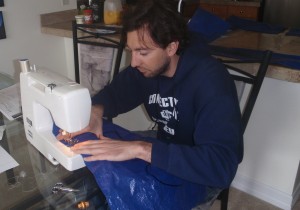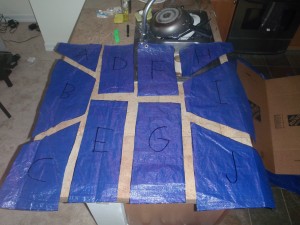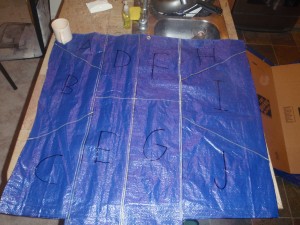Apr 18
Sailboat not Required
I’ll give you two really good reasons why I shouldn’t sew a sail: 1) I know nothing about sewing. 2) I know nothing about sails.
All I know is that two months ago, while chatting about money and our sailboat, Matt said to me, “We definitely need a new sail. Why don’t you sew it for us? It will save us a lot of money and you could do it in Denver. It’s a boat project that doesn’t require a boat.”
It seemed so logical, so rational. Even Sailrite, the company that sells sail-making kits, said it was easy. Zip, zip, zip — and voila — done. Check out the video and see.
Still, intuition suggested that the task would be daunting. When I told my friends, “I’m thinking about sewing a sail,” I couldn’t even keep a straight face. Like so many other boat projects, sailmaking was unfamiliar and overwhelming.
Now, ankle deep as I am in this sailmaking endeavor, I wonder if Matt asked the question in jest. A completed sail is wider and almost as long as my condo (ehem..currently for rent). How the heck am I supposed to do this?
I do know, however, the difference between a code zero, gennaker, asymetric spinaker, drifter, crusing spinaker, and genoa. I know how to thread a bobbin. I know what tension can be applied to different sail luff configurations and how that affects the ability of a sail to go to windward. I also know what tension can be applied to a piece of thread and how that affects looping above and below the fabric. I understand roach. I understand how to walk the dog.
I know this because I did hours of personal research, had several discussions with Matt, read a book, and talked for 30 minutes on the phone with Jeff, the head sailmaster at Sailrite, hitting him with questions I barely have enough knowledge to even be asking, let alone understand the answers. He was extremely helpful, though I’m pretty sure he realized I was a complete greenhorn. We need a sail though, so I pressed on, e-mailed him even more questions the next day, and then called again a few days later.
I know we want something that would work in light air. You see, the breezes in the trade-winds (which blow from 20 degrees north to 20 degrees south of the equator minus about 5 degrees of doldrums right on the equator) are actually fairly wispy most of the time, only 5-15 knots. All of our current sails are made of Dacron, the most common synthetic sail fabric, but which would be too heavy for those light trade winds. Our new sail, called a drifter, will be made of super lightweight nylon, much like tent fabric. We’ll mostly be flying it in what’s called a double-head sail set-up: the jib and the drifter are attached at the forestay, one going to port and the other to starboard, each at about a 90 degree angle to the boat. They create a big parachute the wind pushes against, moving the boat. To use this set-up the wind needs to be coming from generally directly behind you, give or take 20 degrees. Coincidentally, that’s what the wind will usually be like in the trades.
I also know this because I borrowed my sister’s sewing machine, and had my newfound mentor, Lauren, gave me a brief tutorial on using it. Like a good mentor, she stepped back and let me have fun. To start, I ripped off a 4’x4′ section from my 20 foot square blue ground tarp, hoping that it would mimic nylon, because I wasn’t willing to cut up my tent. I then impatiently cut the 4’x4′ square into 6 different pieces to sew back together. Once in a while, when something stopped working and I couldn’t fathom why, I’d ask for help. Otherwise, I showed her my stitching, asked for feedback, and generally felt proud of what I had done.
The process reminded me of the internship programs that my students go through. Every week, they see new things, learn new skills, and push themselves beyond their normal boundaries — under the guidance of amazing mentors. Such opportunities — in school!— are awesome, and I smiled just thinking about it.
Three significant lessons emerged from the reassembly of the first tarp:
1) It would help if I cut up the tarp in straight lines.
2) It would help if I mimicked the way the sail panels would be pre-attached with double-sided tape.
3) It would help if I had more thread.
So we drove over to Fancy Tiger, a local boutique thread-shop. They have a surprising lack of thread, needles, and fabric, but an ungodly amount of yarn, and they also have sewing classes! You get to bring in your own projects and get help! It’s like getting 10 mentors at once, for free! As far as I can tell, there’s no other shop like it for 500 miles.
Back home, I cut out a second piece of tarp. This time with straight lines. I tacked the pieces together with double-sided tape. I used my new, bright yellow (Lauren raised her eyes at my choice, but I wanted bold) thread. The second go was a significant improvement, and my confidence rose ten-fold.
So, now, thanks to so much help, this project seems more manageable. I’ve got Lauren, and my sister, and Jeff, and the entire staff of the local thread-shop as support. With all that scaffolding, it should be easy. Right?



April 18th, 2009 at 11:58 pm
So I watched the video and making a sail looks like hell. Easy? Huh!
April 19th, 2009 at 7:50 am
Gary… where’s the homemaker side of you? C’mon!
April 20th, 2009 at 1:56 am
You should put a big skull and cross-bones on the sail. Then maybe the pirates will leave you alone.